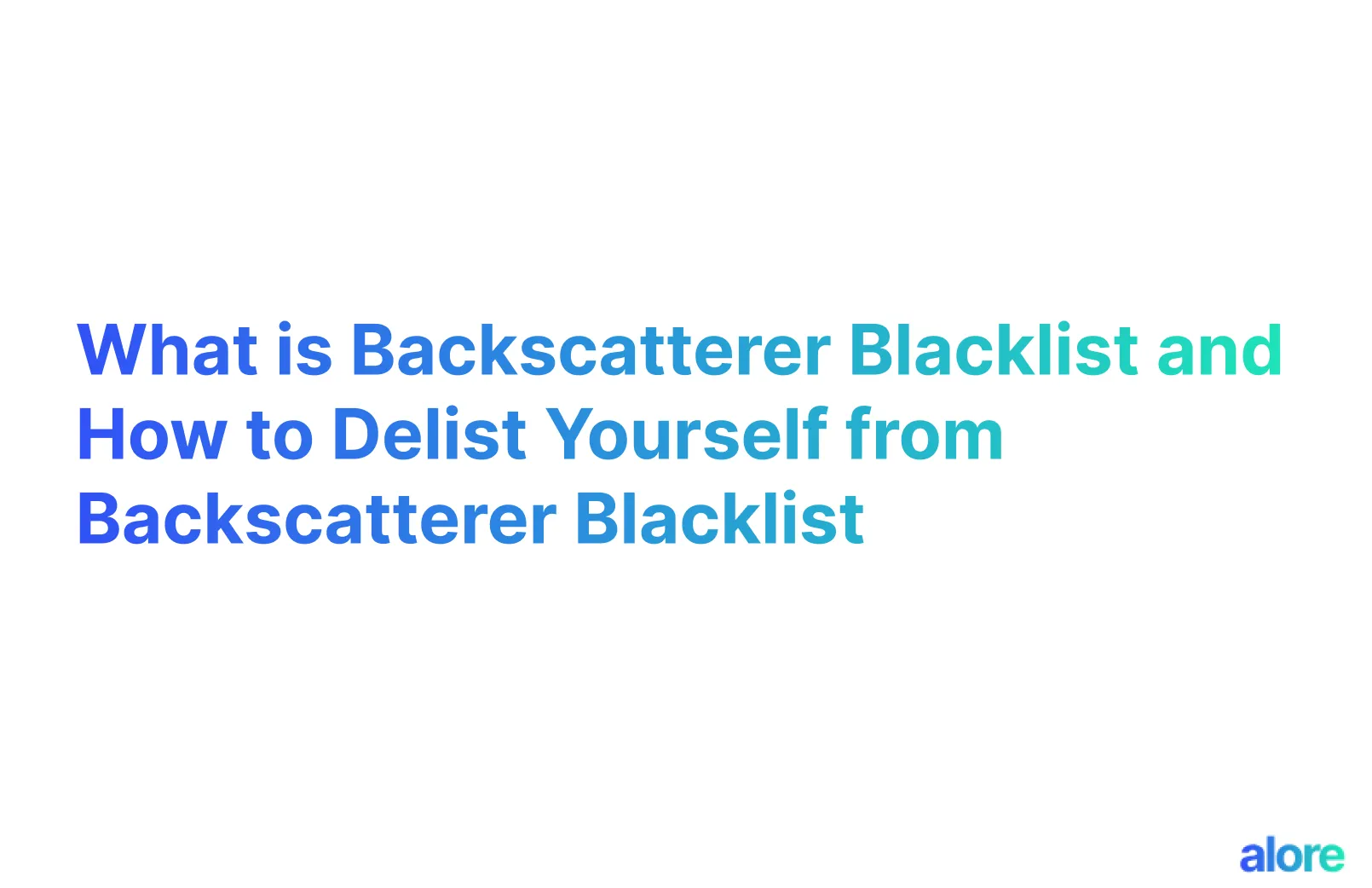Introduction
The Backscatterer Blacklist, a nuanced yet critical aspect of email management, demands a thorough understanding and strategic approach to prevent and resolve email deliverability issues. This guide delves into the Backscatterer Blacklist's intricacies, offering actionable insights for email administrators to safeguard their servers and maintain optimal email flow.
Understanding the Backscatterer Blacklist
The Backscatterer Blacklist, or Backscatter Blackhole List (BBL), targets IP addresses that generate backscatter — unwanted bounce messages sent by mail servers in response to incoming spam. These misdirected bounces, or collateral spam, can significantly burden email systems, leading to performance degradation and potential blacklisting.
Mechanics of the Backscatterer Blacklist
This specialized blacklist monitors email traffic for signs of backscatter, listing IP addresses that frequently send misdirected bounce messages. Being listed indicates that an email server is contributing to the backscatter problem, often unknowingly, due to configuration issues or spam attacks.
Detecting Your IP's Blacklist Status
To check if your IP is affected, use the Backscatterer.org's lookup tool. Regular checks are essential, especially when experiencing email delivery anomalies, to quickly identify and address potential backscatter issues.
Path to Removal from the Backscatterer Blacklist
Automatic delisting occurs when spam activities cease, but this can take time. While manual removal requests are not directly supported, understanding the blacklist's mechanics can guide administrators in resolving the underlying issues, leading to eventual delisting.
Prevention: Key to Avoiding Backscatter Issues
Adopting best email practices is crucial:
- Verify email addresses before sending communications.
- Limit unnecessary email transmissions.
- Avoid spam-triggering language in email content.
- Implement email volume controls, especially when using email warm-up services.
Effective Use of the Backscatterer ListI
ncorporate the Backscatterer list into your email system's DNS queries for a targeted approach in handling misdirected bounces. This integration should be done judiciously to avoid false positives, ensuring legitimate emails are not affected.
Comparative Insight: Backscatterer vs. Other DNS Blacklists
Unlike general spam-focused blacklists like Spamhaus or Barracuda, the Backscatterer Blacklist specifically addresses the backscatter phenomenon. This focus necessitates a different strategic approach in both prevention and resolution.
Email Administrators: Guardians of Email Integrity
Email administrators bear the responsibility of maintaining email system health, which includes:
- Regularly monitoring for backscatter and blacklist inclusion.
- Implementing and updating email authentication measures (SPF, DKIM, DMARC).
- Educating users and stakeholders about best email practices.
Strategies for Long-term Blacklist Management
To ensure ongoing email deliverability and security:
- Continuously monitor and adjust email server configurations.
- Educate users on the importance of email hygiene.
- Stay updated with the latest in email security and blacklist management practices.
Navigating Delisting and Ensuring Compliance
Understand the criteria and processes for delisting from the Backscatterer Blacklist. While direct removal requests are not standard, addressing the root causes of backscatter will naturally lead to delisting.
Building a Robust Email Ecosystem
Beyond immediate blacklist concerns, fostering a healthy email environment involves:
- Regular training and updates for email administrators.
- Advanced monitoring and analytics to preemptively identify risks.
- Strategic planning around email infrastructure and security measures.
FAQ on Backscatterer Blacklist and How to Get Delisted
1. What is the Backscatterer Blacklist?
The Backscatterer Blacklist is a real-time database that identifies IP addresses responsible for sending backscatter emails. Backscatter refers to incorrect or misdirected bounce messages sent by mail servers, usually in response to spam or email sent to nonexistent addresses.
2. How does my IP address get listed on the Backscatterer Blacklist?
Your IP address can get listed if your mail server is improperly configured and sends bounce messages to forged sender addresses, typically found in spam emails. This results in a high volume of unnecessary and misdirected bounce messages, leading to blacklisting.
3. How can I check if my IP is on the Backscatterer Blacklist?
You can check your IP status by visiting the Backscatterer.org website and using their IP lookup tool. Enter your IP address in the provided search box to see if it's currently listed.
4. What are the consequences of being on the Backscatterer Blacklist?
Being listed can lead to email delivery issues, including your legitimate emails being blocked or filtered by other mail servers that use the Backscatterer list to prevent spam.
5. How can I remove my IP from the Backscatterer Blacklist?
Typically, IPs are automatically delisted from the Backscatterer Blacklist once the server stops sending backscatter emails. There is no manual removal process, so you must resolve the issue causing the backscatter to be delisted.
6. How long does it take to get delisted from the Backscatterer Blacklist?
The time it takes to be delisted can vary, but generally, if no further backscatter is detected from your IP, it could be removed within 24 to 48 hours.
7. What steps can I take to prevent getting listed on the Backscatterer Blacklist?
To prevent listing, ensure your mail server is correctly configured to handle bounces properly and does not send bounce messages to forged or incorrect sender addresses. Implementing proper email validation, SPF, DKIM, and DMARC records can also help reduce the likelihood of backscatter.
8. Can I pay to get my IP address removed from the Backscatterer Blacklist?
No, the Backscatterer Blacklist does not offer a paid removal service. The only way to be removed is to stop the behavior that led to the listing.
9. What should I do if I keep getting listed on the Backscatterer Blacklist?
If your IP is repeatedly listed, conduct a thorough review of your mail server's configuration and email practices. Look for security breaches, such as compromised accounts being used to send spam, and ensure your server is not configured to send bounce messages to spurious sender addresses.
10. How can I ensure my mail server does not cause backscatter?
Regularly audit your mail server settings and practices. Use tools and logs to monitor for unusual activity, ensure that your server rejects invalid recipients during the SMTP transaction, and never generates bounce messages for messages it did not accept in the first place.
Further Reading on Email Blacklists and Delisting Processes
For those looking to deepen their understanding of various email blacklists and learn how to effectively manage and remove listings, here are comprehensive guides to assist you:
- Mastering the SEM Fresh Blacklist: Your Complete Guide to Understanding and Delisting
Dive into the specifics of the SEM Fresh Blacklist, including its unique focus on spammy domain names and the steps to delist your domain. - Mastering the Sorbs DUHL Blacklist: Your Complete Guide to Understanding and Delisting
Explore the intricacies of the Sorbs DUHL Blacklist and learn how to navigate the delisting process effectively. - Spamhaus Zen Blacklist: Understanding and Delisting Your Domain
Gain insights into the Spamhaus Zen Blacklist, its impact on your email deliverability, and how to remove your domain from this list. - RATS-Dyna Blacklist: Understanding What it is and How to Get Delisted
Discover what the RATS-Dyna Blacklist entails and the steps required to get your IP address delisted. - What is Backscatterer Blacklist and How to Delist Yourself from Backscatterer Blacklist
Learn about the Backscatterer Blacklist and the process for removing your IP address from this list. - What is Truncate Blacklist & How to Delist Your Domain from Truncate Blacklist
Understand the Truncate Blacklist and find out how to clear your domain from its records. - Understanding UCEPROTECTL1 Blacklist & How to get delisted
Get to know the UCEPROTECTL1 Blacklist and the necessary steps to delist your IP or domain. - UCEPROTECTL2 Blacklist: Comprehensive Guide and Delisting Process
Delve into the details of the UCEPROTECTL2 Blacklist and how to navigate the delisting procedure. - UCEPROTECTL3 Blacklist: Comprehensive Guide and Delisting Process
Explore the comprehensive guide on the UCEPROTECTL3 Blacklist and understand the delisting process. - Understanding the RATS-Spam Blacklist: Definition and Delisting Process
Learn about the RATS-Spam Blacklist and how to effectively remove your IP from this list. - Suomispam Reputation Blacklist: Understanding and Delisting Guide
Discover the Suomispam Reputation Blacklist and the steps to clear your domain or IP from its records.
These resources provide valuable insights and actionable steps to help you manage and mitigate the impact of blacklisting on your email deliverability and reputation.





.webp)


